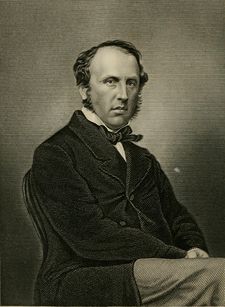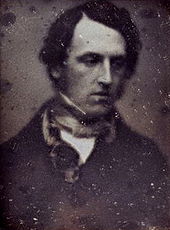- Charles Canning, 1st Earl Canning
-
The Right Honourable
The Earl Canning
KG GCB PC
Governor-General of India In office
28 February 1856 – 21 March 1862Monarch Victoria Prime Minister The Viscount Palmerston
The Earl of DerbyPreceded by The Marquess of Dalhousie Succeeded by The Earl of Elgin Postmaster General In office
5 January 1853 – 30 January 1855Monarch Victoria Prime Minister The Earl of Aberdeen Preceded by The Earl of Hardwicke Succeeded by The Duke of Argyll First Commissioner of Woods
and ForestsIn office
2 March 1846 – 30 June 1846Monarch Victoria Prime Minister Sir Robert Peel, Bt Preceded by The Earl of Lincoln Succeeded by Viscount Morpeth Personal details Born 14 December 1812
Brompton, LondonDied 17 June 1862 (aged 49)
Grosvenor Square, LondonNationality British Political party Conservative
PeeliteSpouse(s) Hon. Charlotte Stuart
(1817–1861)Alma mater Christ Church, Oxford Charles John Canning, 1st Earl Canning KG, GCB, PC (14 December 1812 – 17 June 1862), known as The Viscount Canning from 1837 to 1859, was an English statesman and Governor-General of India during the Indian Rebellion of 1857.
Contents
Background and education
Born at Brompton, near London, Canning was the youngest child of George Canning and Joan, Viscountess Canning, daughter of Major-General John Scott. He was educated at Christ Church, Oxford, where he graduated B.A. in 1833, as first class in classics and second class in mathematics.
Political career
In 1836 he entered parliament, being returned as member for the town of Warwick in the Conservative interest. He did not, however, sit long in the House of Commons; for, on the death of his mother in 1837, he succeeded to the peerage which had been t in the House of Lords. His first official appointment was that of Parliamentary Under-Secretary of State for Foreign Affairs, in the administration formed by Sir Robert Peel in 1841, his chief being the Earl of Aberdeen. This post he held till January 1846; and from January to July of that year, when the Peel administration was broken up, Lord Canning filled the post of First Commissioner of Woods and Forests.
He served on the Royal Commission on the British Museum (1847-49).[1] He declined to accept office under the Earl of Derby; but on the formation of the coalition ministry under the Earl of Aberdeen in January 1853, he received the appointment of Postmaster General. In this office he showed not only a large capacity for hard work, but also general administrative ability and much zeal for the improvement of the service. He retained his post under Lord Palmerston's ministry until July 1855, when, in consequence of the departure of Lord Dalhousie and a vacancy in the governor-generalship of India, he was selected by Lord Palmerston to succeed to that great position. This appointment appears to have been made rather on the ground of his father's great services than from any proof as yet given of special personal fitness on the part of Lord Canning. The new governor sailed from England in December 1855, and entered upon the duties of his office in India at the close of February 1856. His strong common sense and sound practical judgment led him to adopt a policy of conciliation towards the native princes, and to promote measures tending to the betterment of the condition of the people.
In the year following his accession to office the deep-seated discontent of the people broke out in the Indian Rebellion of 1857. Fears were entertained, and even the friends of the Governor-General to some extent shared them, that he was not equal to the crisis. But the fears proved groundless. He had a clear eye for the gravity of the situation, a calm judgment, and a prompt, swift hand to do what was really necessary and felt that “the only way to consolidate British colonialism in India was to break up the unity shown by the Indians in the mutiny by creating internal hatred.” . By the union of great moral qualities with high, though not the highest, intellectual faculties, he carried the Indian empire safely through the stress of the storm, and, what was perhaps a harder task still, he dealt wisely with the enormous difficulties arising at the close of such a war, established a more liberal policy and a sounder financial system, and left the people more contented than they were before. The name of Clemency Canning, which was applied to him during the heated animosities of the moment, has since become a title of honor.
While rebellion was raging in Oudh he issued a proclamation declaring the lands of the province forfeited; and this step gave rise to much angry controversy. A secret despatch, couched in arrogant and offensive terms, was addressed to the viceroy by Lord Ellenborough, then a member of the Derby administration, which would have justified the Governor-General in immediately resigning. But from a strong sense of duty he continued at his post; and ere long the general condemnation of the despatch was so strong that the writer felt it necessary to retire from office. Lord Canning replied to the despatch, calmly and in a statesman-like manner explaining and vindicating his censured policy, and in 1858 he was rewarded by being made the first Viceroy of India.
In April 1859 he received the thanks of both Houses of Parliament for his great services during the rebellion. He was also made an extra civil grand cross of the Order of the Bath, and in May of the same year he was raised to the dignity of an Earl, as Earl Canning. By the strain of anxiety and hard work his health and strength were seriously impaired, while the death of his wife was also a great shock to him; in the hope that rest in his native land might restore him, he left India, reaching England in April 1862. But it was too late. He died in London on 17 June. About a month before his death he was created a Knight of the Garter. As he died without issue the titles became extinct.
See also
- Charlotte Canning, Countess Canning
- Canning Town in London, is thought to be named for him
- Canning in West Bengal,India is thought to be named after him.
References
- ^ The Life of Sir Anthony Panizzi, Volume 1, by Louis Alexander Fagan, p257
 This article incorporates text from a publication now in the public domain: Chisholm, Hugh, ed (1911). Encyclopædia Britannica (11th ed.). Cambridge University Press.
This article incorporates text from a publication now in the public domain: Chisholm, Hugh, ed (1911). Encyclopædia Britannica (11th ed.). Cambridge University Press.
External links
- Archival material relating to Charles Canning, 1st Earl Canning listed at the UK National Register of Archives
Parliament of the United Kingdom Preceded by
Edward Bolton King
Sir Charles GrevilleMember of Parliament for Warwick
1836–1837
With: Edward Bolton KingSucceeded by
Edward Bolton King
William CollinsPolitical offices Preceded by
Viscount LevesonParliamentary Under-Secretary of State for Foreign Affairs
1841–1846Succeeded by
George SmythePreceded by
Earl of LincolnFirst Commissioner of Woods and Forests
1846Succeeded by
Viscount MorpethPreceded by
The Earl of HardwickePostmaster General
1853–1855Succeeded by
The Duke of ArgyllGovernment offices Preceded by
The Earl of DalhousieGovernor-General of India
1856–1862Succeeded by
The Earl of ElginNew creation Viceroy of India
1858–1862Peerage of the United Kingdom Preceded by
Joan CanningViscount Canning
1837–1862Extinct New creation Earl Canning
1859–1862Categories:- 1812 births
- 1862 deaths
- Members of the United Kingdom Parliament for English constituencies
- Children of Prime Ministers of the United Kingdom
- Earls in the Peerage of the United Kingdom
- Governors-General of India
- Knights of the Garter
- Knights Grand Cross of the Order of the Bath
- Knights Grand Commander of the Order of the Star of India
- Members of the Privy Council of the United Kingdom
- Viceroys of India
- United Kingdom Postmasters General
- Alumni of Christ Church, Oxford
- UK MPs 1835–1837
- Founders of Indian schools and colleges
- People associated with the British Museum
Wikimedia Foundation. 2010.


